非谓语动词之过去分词
- 格式:doc
- 大小:62.00 KB
- 文档页数:6

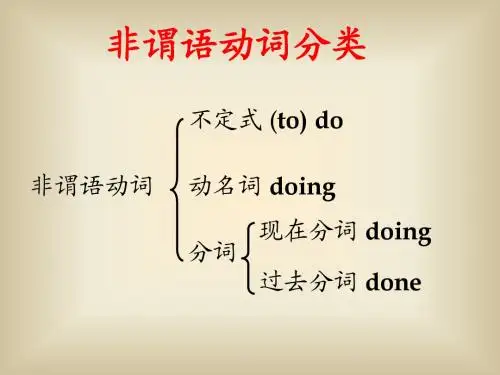
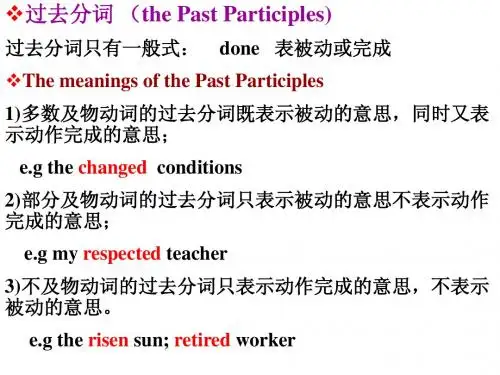

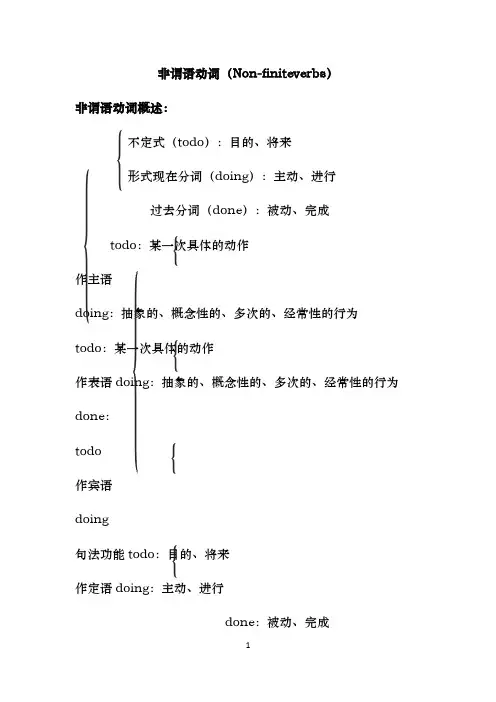
非谓语动词(Non-finiteverbs)非谓语动词概述:不定式(todo):目的、将来形式现在分词(doing):主动、进行过去分词(done):被动、完成todo:某一次具体的动作作主语doing:抽象的、概念性的、多次的、经常性的行为todo:某一次具体的动作作表语doing:抽象的、概念性的、多次的、经常性的行为done:todo作宾语doing句法功能todo:目的、将来作定语doing:主动、进行done:被动、完成todo:目的、将来作宾补doing:主动、进行done:被动、完成todo:目的、将来作状语doing:主动、进行done:被动、完成独立成分作状语n./pron.+todo/doing/done独立主格结构with的复合结构GrammarI:非谓语动词的形式(一)过去分词:过去分词只有一种形式,就是一般式done。
①单独表示一个被动的动作;②也可以单独表示动作已经完成;③还可以同时表示被动和完成。
(二)现在分词的各种形式:(三)主动被动用法一般doing beingdone doing的动作与谓语动作几e.g.1._______________(hear)thenews,theycouldn’thelpla ughing.e.g.2.Not________________(finish)thetask,theyhavetostayt hereforanothertwoweeks.e.g.3.________________(turn)offtheTVset,hebegantogoover (复习)hislessons.e.g.4.______________(heat加热),thewatergetshot.e.g.5._______________(build)forhalfayear,thebuildingbeca meourlibrary.e.g.6._______________(tell)manytimes,hestillrepeated(重复)thesamemistake.e.g.7.Isawtherewasaboy________________(blame)byhisfat her.(四)不定式的各种形式(五)e.g.1.Therearemanydishes_________________(wash)inthek itchen.SoIdon’thavetimetoseeafilmwithyoutonight.注意:非谓语动词的否定形式是在其前加notGrammarII:todo、doing作主语或表语一、todo、doing作主语的一般用法:e.g.1.Toswimtodayisagoodideae.g.2.Eatingtoomuchisbad foryourhealth.思考:todo作主语,表__________________________________________________的动作;doing作主语,表_________________________________________________的动作。

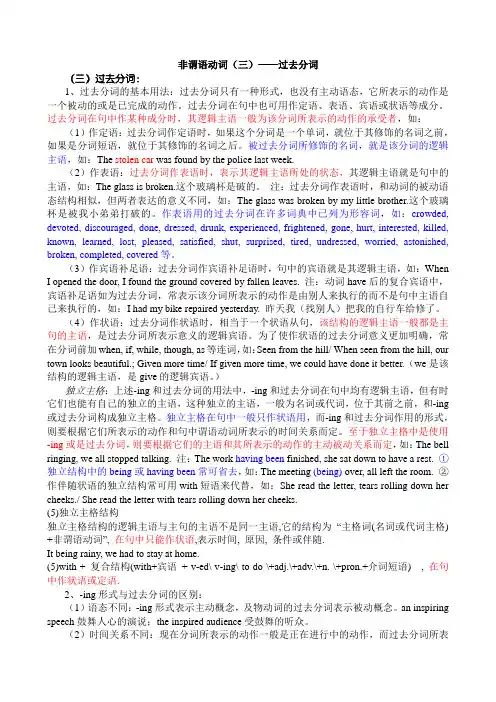
非谓语动词(三)——过去分词(三)过去分词:1、过去分词的基本用法:过去分词只有一种形式,也没有主动语态,它所表示的动作是一个被动的或是已完成的动作。
过去分词在句中也可用作定语、表语、宾语或状语等成分。
过去分词在句中作某种成分时,其逻辑主语一般为该分词所表示的动作的承受者,如:(1)作定语:过去分词作定语时,如果这个分词是一个单词,就位于其修饰的名词之前,如果是分词短语,就位于其修饰的名词之后。
被过去分词所修饰的名词,就是该分词的逻辑主语,如:The stolen car was found by the police last week.(2)作表语:过去分词作表语时,表示其逻辑主语所处的状态,其逻辑主语就是句中的主语,如:The glass is broken.这个玻璃杯是破的。
注:过去分词作表语时,和动词的被动语态结构相似,但两者表达的意义不同,如:The glass was broken by my little brother.这个玻璃杯是被我小弟弟打破的。
作表语用的过去分词在许多词典中已列为形容词,如:crowded, devoted, discouraged, done, dressed, drunk, experienced, frightened, gone, hurt, interested, killed, known, learned, lost, pleased, satisfied, shut, surprised, tired, undressed, worried, astonished, broken, completed, covered等。
(3)作宾语补足语:过去分词作宾语补足语时,句中的宾语就是其逻辑主语,如:When I opened the door, I found the ground covered by fallen leaves. 注:动词have后的复合宾语中,宾语补足语如为过去分词,常表示该分词所表示的动作是由别人来执行的而不是句中主语自己来执行的,如:I had my bike repaired yesterday. 昨天我(找别人)把我的自行车给修了。

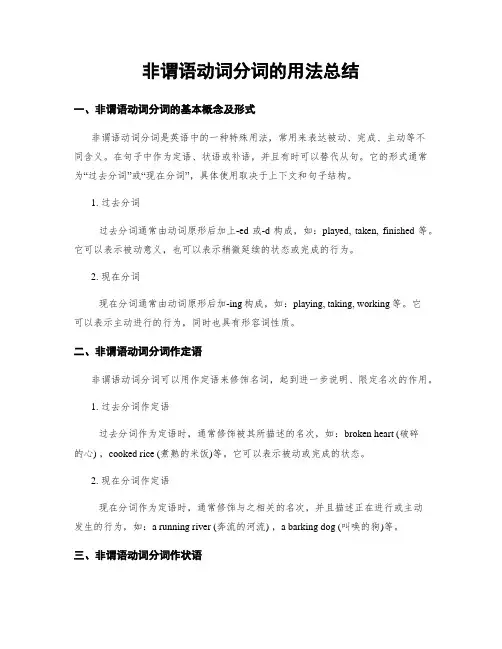
非谓语动词分词的用法总结一、非谓语动词分词的基本概念及形式非谓语动词分词是英语中的一种特殊用法,常用来表达被动、完成、主动等不同含义。
在句子中作为定语、状语或补语,并且有时可以替代从句。
它的形式通常为“过去分词”或“现在分词”,具体使用取决于上下文和句子结构。
1. 过去分词过去分词通常由动词原形后加上-ed或-d构成,如:played, taken, finished等。
它可以表示被动意义,也可以表示稍微延续的状态或完成的行为。
2. 现在分词现在分词通常由动词原形后加-ing构成,如:playing, taking, working等。
它可以表示主动进行的行为,同时也具有形容词性质。
二、非谓语动词分词作定语非谓语动词分词可以用作定语来修饰名词,起到进一步说明、限定名次的作用。
1. 过去分词作定语过去分词作为定语时,通常修饰被其所描述的名次,如:broken heart (破碎的心) ,cooked rice (煮熟的米饭)等。
它可以表示被动或完成的状态。
2. 现在分词作定语现在分词作为定语时,通常修饰与之相关的名次,并且描述正在进行或主动发生的行为,如:a running river (奔流的河流) ,a barking dog (叫唤的狗)等。
三、非谓语动词分词作状语非谓语动词分词可以用作状语来修饰句子、从句或名词短语,起到表示时间、原因、方式、条件等不同功能的作用。
1. 过去分词作状语过去分词作为状语时,可以表示原因、结果、条件、时间等。
例如:Having finished his homework, he went out to play. (完成了家庭作业后,他出去玩了)2. 现在分词作状语现在分词作为状语时,可以表达同时进行、原因、方式等含义。
例如:Walking slowly, she enjoyed the beautiful scenery. (慢慢地走着,她欣赏美丽的风景)四、非谓语动词分词作补语非谓语动词分词还可以用来充当及物动词的宾补或形容词的补足语,起到补充说明、进一步描述的作用。
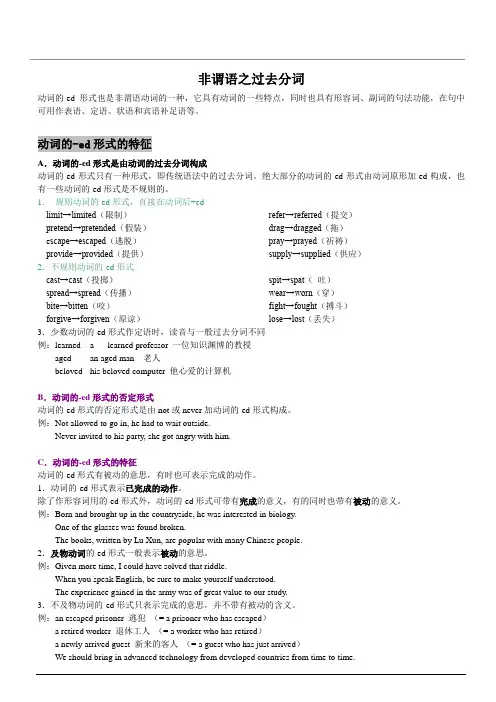
非谓语之过去分词动词的-ed形式也是非谓语动词的一种,它具有动词的一些特点,同时也具有形容词、副词的句法功能,在句中可用作表语、定语、状语和宾语补足语等。
动词的-ed形式的特征A.动词的-ed形式是由动词的过去分词构成动词的-ed形式只有一种形式,即传统语法中的过去分词。
绝大部分的动词的-ed形式由动词原形加-ed构成,也有一些动词的-ed形式是不规则的。
1.规则动词的-ed形式,直接在动词后+edlimit→limited(限制)pretend→pretended(假装)e scape→escaped(逃脱)provide→provided(提供)refer→referred(提交)drag→dragged(拖)pray→prayed(祈祷)supply→supplied(供应)2.不规则动词的-ed形式cast→cast(投掷)spread→spread(传播)bite→bitten(咬)forgive→forgiven(原谅)spit→spat(吐)wear→worn(穿)fight→fought(搏斗)lose→lost(丢失)3.少数动词的-ed形式作定语时,读音与一般过去分词不同例:learned a learned professor 一位知识渊博的教授aged an aged man 老人beloved his beloved computer 他心爱的计算机B.动词的-ed形式的否定形式动词的-ed形式的否定形式是由not或never加动词的-ed形式构成。
例:Not allowed to go in, he had to wait outside.Never invited to his party, she got angry with him.C.动词的-ed形式的特征动词的-ed形式有被动的意思,有时也可表示完成的动作。
1.动词的-ed形式表示已完成的动作。
除了作形容词用的-ed形式外,动词的-ed形式可带有完成的意义,有的同时也带有被动的意义。

非谓语形式有三种:1、动词不定式:to do2、动词的ing : doing3、动词的过去分词:done。
其中不定式表示目的和将来;动词的ing表示主动和进行;过去分词表示被动和完成。
非谓语动词三种形式在句中充当不同的成分,表达不同的意义,具体如下表:非谓语动词的时态和语态:一般式:不定式:主动to do ,被动to be done ; ing 形式:主动doing ,被动being done ;过去分词:被动done完成式:不定式:主动to have done ,被动to have been done;ing 形式:主动having done,被动having been done进行式:不定式to be doing1、动词不定式的基本用法:动词不定式能起名词、形容词和副词的作用,可在句中作主语、表语、宾语补足语、定语和状语用,(to)+ do,具有名词、形容词、副词的特征。
否定式:not + (to) do 如:(1)作主语:动词不定式作主语时,一般可用it作形式主语,而将作主语的动词不定式置于句末,如:It is very hard to finish the work in ten minutes. 十分钟之内完成这项工作是很难的。
It means failure to lose your heart. 灰心意味着失败。
常用句式有:1、It+be+名词+to do。
2、It takes sb.+some time+to do。
(2)作表语:动词不定式在系动词be之后作表语,与表示将来时的be + 动词不定式结构有所区别。
如:Her job is to clean the hall. 她的工作是打扫大厅。
(3)作宾语:①作及物动词的宾语,如:She wishes to be a musician.;②作某些形容词的宾语:可以有动词不定式为宾语的形容词一般有glad, sorry, afraid, pleased, determined, willing, eager, anxious, ready, sure等;③动词不定式一般不作介词的宾语,但动词不定式之前如有疑问词时,就可作介词的宾语,如:Can you give us some advice on what to do next?(4)作宾语补足语:在复合宾语中,动词不定式可充当宾语补足语,如下动词常跟这种复合宾语:want,wish,ask,tell,order,beg,permit,help,advise,persuade,allow,prepare,cause,force,call on,wait for,invite.此外,介词有时也与这种复合宾语连用,如:With a lot of work to do,he didn't go to the cinema.他有很多工作要做,所以没去电影院。
过去分词的用法一、过去分词作定语用法〔Past Participles Used as Attributes〕过去分词作定语,在语态上,表被动;在时间上,表示动作已经发生或完成,与它所修饰的名词有逻辑〔意义〕上的动宾关系。
过去分词作定语表示动作在谓语动作之前发生,已经完成并具有被动意义。
有时也不表示时间性。
作定语的过去分词一般由及物动词变来,因为只有及物动词才有被动意义。
He is a teacher loved by his students.也有用不及物动词的过去分词作定语的情况,一般作前置定语,它不表示被动意义,只表示主动意义,强调动作完成。
不能像及物动词的过去分词那样放在名词后面作定语。
例如:Fallen leaves retired workers the risen sun注意一下几点:1. 单个的过去分词作定语一般放在被修饰的名词之前。
例如:We needed much more qualified workers. My friend is a returned student. 单个分词也可以作后置定语,用以强调动作。
They decided to change the material used.2. 过去分词短语作定语要放在被修饰的名词后面,作后置定语,其作用相当于一个定语从句。
The student dressed in white is my daughter.=The student who is dressed in white is my daughter.)3. 如果被修饰的词是由every/some/any/no + thing/body/one所构成的复合代词或指示代词those等时,即使一个单一的分词做定语,也要放在被修饰词的后面。
Is there anything unsolved?There is noting changed here since I left this town.4. 单个过去分词前加一名词或副词,常用连字符将它们连接起来构成一个复合形容词,放在其修饰的名词前,作前置定语。
非谓语动词三过去分词定义:过去分词既具有动词的特征,又具备形容词和副词的语法功能. 表完成、被动、状态。
1做定语表完成\被动。
表完成----这类词有:gone, come, fallen, risen, changed, arrived, returned, passed等。
Boiled water [开了的水] Fallen leaves[落叶] Newly arrived goods[0新到的货] The risen sun[升起的太阳] The changed world The changed out looking.表被动:A invited client [一位受邀请的客人] The window broken by the little boy The car found by the local police The injured worker was sent away.※注※:分词单独作定语时,放在被修饰词语前面Our class went on an [organized] trip last Monday.分词短语做定语时,放在被修饰词语后面Those [elected as committee members] will attend the meeting. ※注※:过去分词做定语,相当于一个定语从句:Our class went on an trip [which was organized] last Monday.Those [ who were elected as committee members] will attend the meeting.2做表语: 表状态----表示其[逻辑主语] 所处的状态:[注:被动语态中,动作的承受者称为[逻辑主语],如She was seen by me中She是逻辑主语,Me是实际主语。
] The window is broken. We feel bored. She looks disappointed.They became confused. The door remained locked. We are pleased with the meal.The case stay closed. They were frightened at the sad sight.※注※:作表语的过去分词在字典中已经被列为形容词Crowed Devoted Discouraged Done Dressed Experienced Frightened Broken Drunk Learned Satisfied interested killed known Undressed Surprised Hurt Gone Worried Lost Completed Shut covered Astonished Pleased※注※:表状态的过去分词有:Lost Seated Hiddden Lost in Dressed inFrightened Satisfied tired Disappointed Interested Relaxed Pleased Scared.常用的词组Stationed Absorbed in[沉溺于] Born Dressed in Tired of Fixed on Prepared for Furnished with Equipped with Devoted to Armed with Caught in Located in situated in Employed in Delighted at Disappointed at Surprised at Shocked at Astonished at Experienced in Satisfied with concerned with Worried about Supposed to crowed with Determined to.※注※: B e+过去分词,过去分词可作表语也可充当被动语态。
Unit 1过去分词做定语和表语Part 1 过去分词作定语[例句] 仔细观察下列句子中的过去分词的用法。
1. The polluted water was to blame.2. We should also respect the retired workers.3. Paper cuts used for religious purposes are often found in temples.4. He is a teacher loved by his students.5. The student dressed in white is my daughter. = The student who is dressed in white is my daughter.[归纳]1. 过去分词作定语时,表示的动作在______之前发生,已经完成(见句1)。
作定语的过去分词由_____动词变时,和所修饰的词语之间是________关系。
不及物动词的过去分词也可作定语,一般作前置定语,不表示被动意义,只强调动作完成。
如句2中的retired , 又如:_______________落叶;_________________升起的太阳。
2. 单个的过去分词作定语一般放在被修饰的名词_____(见句1、句2)。
_____作定语要放在被修饰的名词后面,作后置定语,表示被动或完成,其作用相当于一个______(见句3、句4、句5)。
[拓展]2. 如果被修饰的词是由every / some / any / no + thing / body / one所构成的复合代词或指示代词those或these等时,即使是单一的过去分词作定语,也要放在被修饰词的后面。
如:There is nothing changed here since I left this town.3. 过去分词短语有时还可用作非限制性定语,相当于一个非限制性定语从句,前后用逗号分开。
如:Some of them, born and brought up in rural villages, had never seen a train.【练一练】一、用所给单词的适当形式填空。
1.This is the severely ___________(pollute) lake I mentioned to you the other day.2.Huang Lin ______________(educate) in Germany has the ability to deal with sucha situation well.3. Do you know the number of books___________(order) by the library?4. Most of the artists_____________________(invite)to the party were from South America.5. Don’t use words, expressions or phrases only__________________(know) to people with special knowledge.二、完成句子(运用过去分词做定语)1. 在会议上提出的问题对我们来说很严重。
The problem ______________ at the meeting is serious to us.2. 不要担心。
在结冰的湖上滑冰是相当安全的。
Don’t worry. It’s quite safe skating on the _______________.3. 为了把英语学好,你应该提高你的口语和书面英语。
In order to learn English well, you should improve your _____________and __________________.4.他十分同情暴晒在太阳下的农民工。
_________________________________________________________5.靠近窗户有一个装满书的书架。
__________________________________________________________注意:不定式、-ing分词及动词的过去分词做定语的区别(1) 不定式作定语时,表示即将发生的动作;-ing分词作定语时,表示主动或正在发生的动作;动词的过去分词作定语时,表示已经完成的动作。
如:The text to be learnt tomorrow is said to be very difficult. 明天要学的那篇课文据说很难。
The song learnt last week is very interesting. 上周所学的那首歌很有趣。
The sleeping boy is Li Lei’s bother. 正在睡觉的男孩是李蕾的弟弟。
The boiled water can be drunk. 开过的水可以被饮用。
The question ________________________ this afternoon is of great importance.今天下午要讨论的问题很重要。
The question ___________ last night is of great importance. 昨晚所讨论的问题很重要。
The question _______________ now is of great importance. 现在所讨论的问题很重要。
(2) 使-ing分词作定语时,表示事物的性质或特征;使动词的过去分词作定语时,表示人的心理状态。
如:an interesting story 有趣的故事an interested boy 感兴趣的男孩a surprising gift 意想不到的礼物 a surprised cry 感到吃惊的叫声a moving deed 一件感人的事迹 a moved group很受感动的人群a frightening dog 令人害怕的狗 a frightened boy 感到害怕的男孩an exhausting job令人疲倦的工作 an exhausted expression 疲惫的表情Part 2 过去分词作表语[例句] 仔细观察下列句子中的过去分词的用法。
1. The street is lined with small shops.2. Tom was astonished to see his father.[归纳]过去分词作表语时,与谓语动词构成_____结构,表示主语的性质、特征和状态。
[辨析]1. 过去分词作表语时与被动语态的区别:过去分词作表语,主要表示主语的状态和特征,而被动语态则表示动作。
如:The cup was broken by my little sister yesterday.The library is now closed.2.有些动词如interest, worry, surprise, frighten等通常用其过去分词形式来说明人的情况,用动词-ing形式来说明物的情况。
如:The book is interesting and I’m interested in it.[强化训练] 从A、B、C、D中选出最佳选项。
1. The Empe ror’s New Clothes is an ______ text. All of us are ______ about it.A. exciting; excitingB. excited; excitedC. excited; excitingD. exciting; excited2. With ______ leaves ______ in the earth every year, the soil becomes richer and richer.A. falling; buryingB. fallen; buriedC. fallen; buryingD. falling; buried3. —I’m very ______ with the dish I cooked. It looks nice and smells delicious. —Mm. It does have a ______ smell.A. pleasant; pleasedB. pleased; pleasedC. pleasant; pleasantD. pleased; pleasant4. I have read plenty of books ______ by Lu Xun.A. writtenB. wroteC. writesD. writing5. His nephew, ______ at sea when he was fifteen, had been his only relative.A. losingB. losesC. lostD. being lost6. They had beef and ______ for supper.A. smoking fishB. fish smokingC. fish to smokeD. smoked fish7. She asked if there was anything _______ for tonight.A. to planB. plannedC. that plansD. Planning【巩固练习】一.使用—ing从句或-ed从句, 使两个句子合并为一句.1.I didn’t talk much to the man. The man was sitting next to me on the plane.2.The taxi broke down. The taxi was taking us to the airport.3.At the end of the street there is a path. The path leads to the river.4. A window was broken in the storm last night. It has now been repaired.5. A number of suggestions were made at the meeting. Most of them were notpractical(实际的)..6. A man was arrested(逮捕) by the police. What was his name?二,选择正确答案。